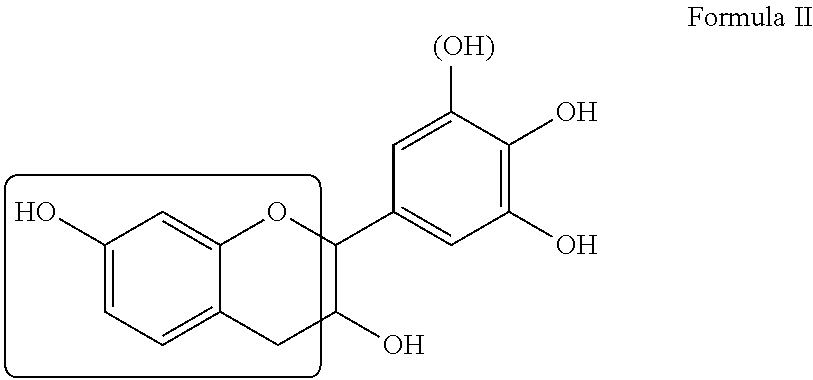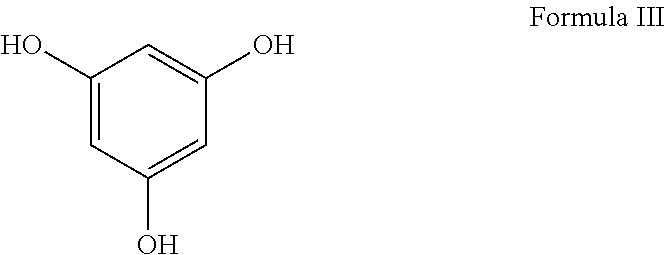Adhesive compositions having a reduced cure time and methods for making and using same
a technology of adhesive composition and cure time, which is applied in the field of adhesive compositions having a reduced cure time and methods for making and using same, can solve the problems of slow product production, slow cure time of adhesives at ambient temperature, and difficulty in making products with phenolic-aldehyde adhesives, so as to improve the cure time and reduce the concentration of metals. , the effect of improving the cure tim
- Summary
- Abstract
- Description
- Claims
- Application Information
AI Technical Summary
Benefits of technology
Problems solved by technology
Method used
Image
Examples
examples
[0124]In order to provide a better understanding of the foregoing discussion, the following non-limiting examples are offered. Although the examples may be directed to specific embodiments, they are not to be viewed as limiting the invention in any specific respect. All parts, proportions, and percentages are by weight unless otherwise indicated.
example i
[0125]The comparative example (C1) was prepared by mixing a phenol-resorcinol-formaldehyde resin and paraformaldehyde (hardener) to provide a comparative adhesive composition. The phenol-resorcinol-formaldehyde resin had a solids content of about 56 wt %, a pH of about 10, a viscosity of about 1,300 cP, and a molar ratio of phenol:resorcinol:formaldehyde of about 0.72:0.54:1. The paraformaldehyde was diluted to a solids concentration of about 50 wt % by mixing with a polyol. The paraformaldehyde / polyol mixture had a viscosity of about 4,500 cP, and a pH of about 5.5. Inventive examples (Ex. 1-8) were prepared with the same phenol-resorcinol-formaldehyde resin and hardener as the comparative example and further included diethylenetriamine (DETA) as the cure accelerant. The amount of DETA increased from 0.05 wt % (Ex. 1) to 0.4 wt % (Ex. 8) in 0.05 wt % increments, based on the combined weight of the phenol-resorcinol-formaldehyde resin and the DETA. The DETA was purchased from Huntsm...
example ii
[0129]The gel time for another series of adhesive compositions (C2 and Ex. 9-14) was also measured to determine the repeatability of the first test discussed in Example I. The phenol-resorcinol-formaldehyde resin, DETA, and paraformaldehyde (hardener) were the same as used in Example I. The only difference between the examples was that the paraformaldehyde (hardener) from a different batch / lot was used, with the properties of the paraformaldehyde being the same as in Example I.
TABLE 2Gel Time Test ResultsPRFCureCureGelResin,Hardener,Accelerant,AccelerantTime,Examples(g)(g)(g)(wt %)(minutes)C270.00030.000NoneNone30Ex. 969.93030.0000.0700.1019Ex. 1068.89530.0000.1050.1513Ex. 1169.82530.0000.1750.256Ex. 1269.82530.0000.1750.256Ex. 1369.75530.0000.2450.354Ex. 1469.68530.0000.3150.453
[0130]As shown in Table 2, the reduction in gel time of phenol-resorcinol-formaldehyde resin and paraformaldehyde (hardener) with the addition of DETA as a cure accelerant were the same as the gel times meas...
PUM
| Property | Measurement | Unit |
|---|---|---|
| Time | aaaaa | aaaaa |
| Concentration | aaaaa | aaaaa |
| Adhesivity | aaaaa | aaaaa |
Abstract
Description
Claims
Application Information
 Login to view more
Login to view more - R&D Engineer
- R&D Manager
- IP Professional
- Industry Leading Data Capabilities
- Powerful AI technology
- Patent DNA Extraction
Browse by: Latest US Patents, China's latest patents, Technical Efficacy Thesaurus, Application Domain, Technology Topic.
© 2024 PatSnap. All rights reserved.Legal|Privacy policy|Modern Slavery Act Transparency Statement|Sitemap



